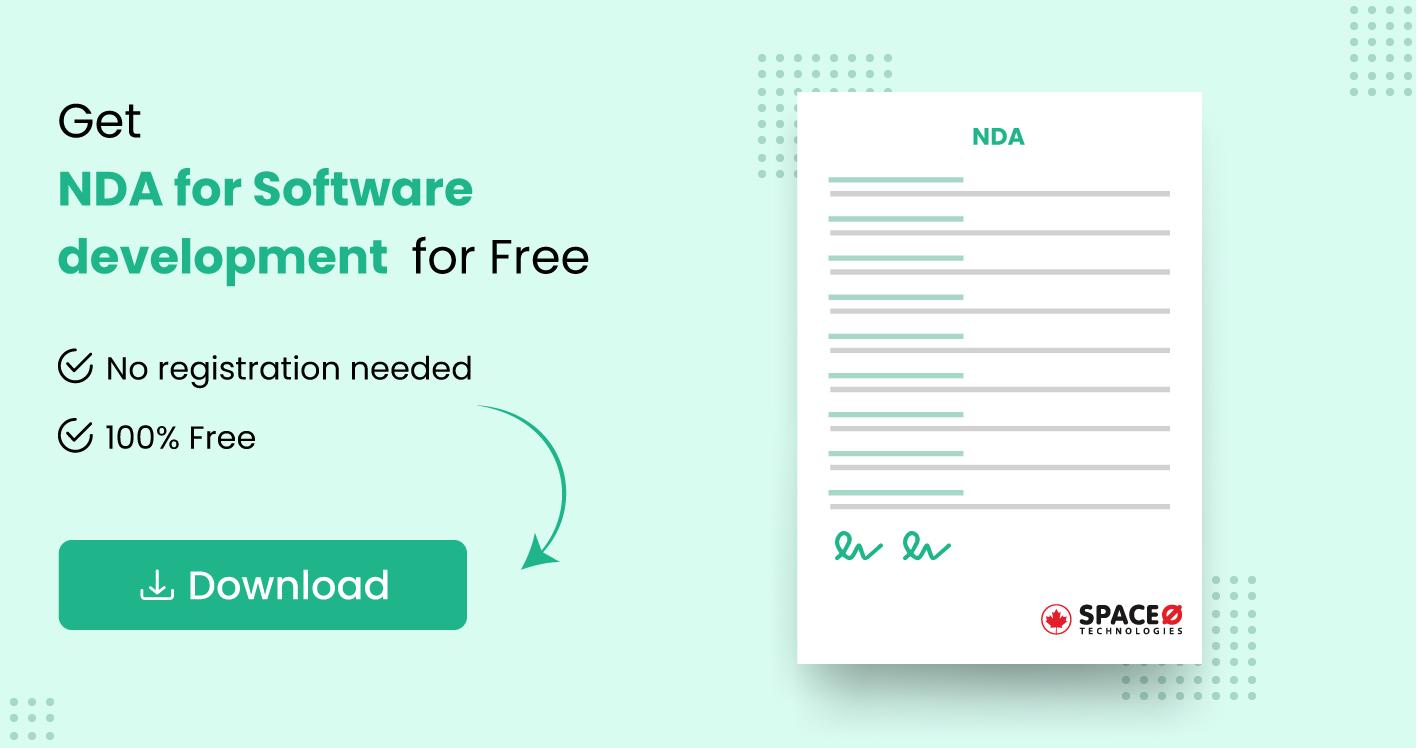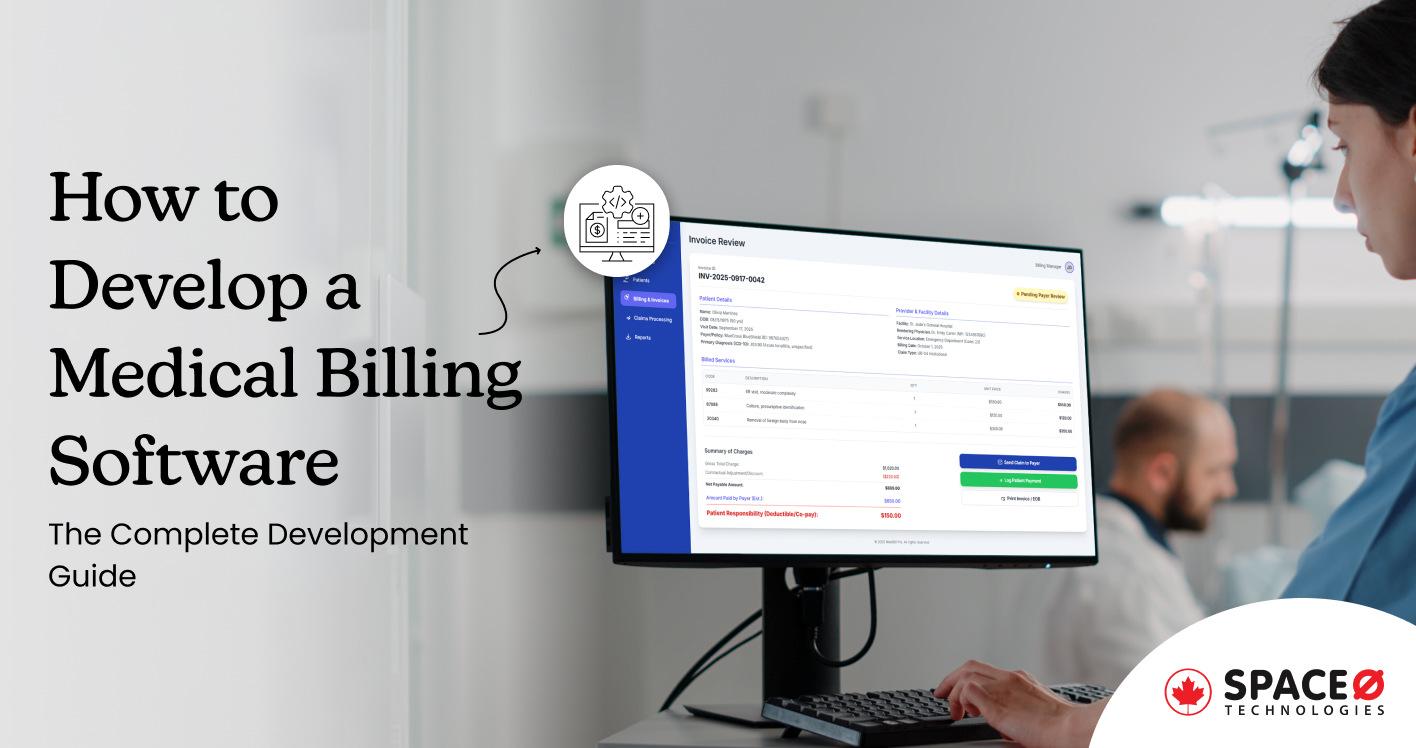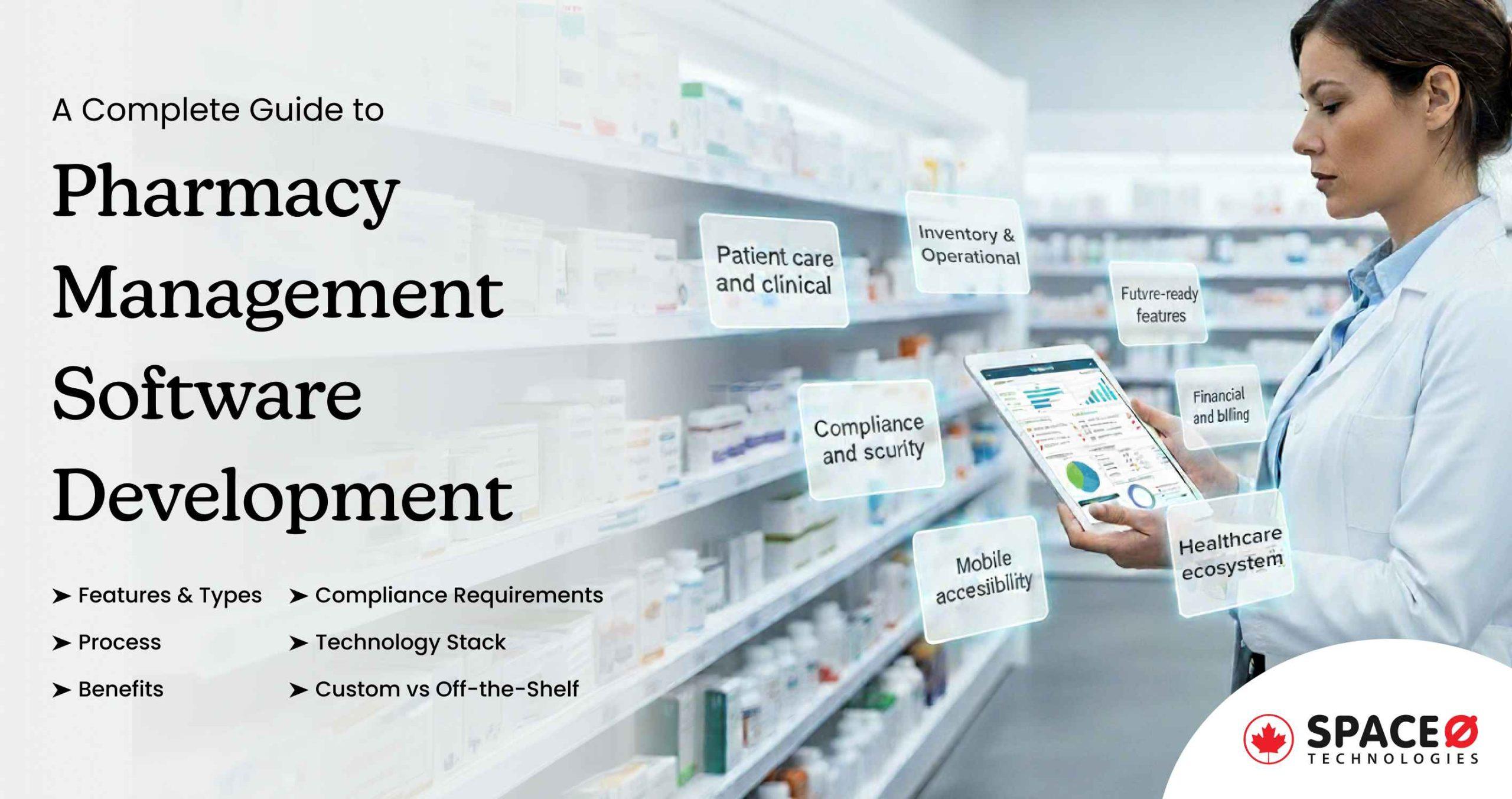
NDA for Software Development: A Complete Guide With Template
Have you ever wondered how to protect your software app ideas? When your ideas are leaked, your time, money, and efforts get wasted. That’s where an (NDA) non-disclosure agreement plays an important role. This legal document makes sure all the information of your software project like project plans, codes, and business strategies, remains confidential.
We understand the importance of signing an NDA before moving ahead to develop a software solution. As a leading bespoke software development company, we make sure our clients’ information remains safe and secure, thus, educating clients about signing an NDA. If you are unfamiliar with NDAs and want a deeper understanding, read this guide on NDA for software development.
Table of Contents
What is NDA in Software Development?
A non-disclosure agreement is a legal contract signed between two parties, a software development company and a client. The purpose of signing a non-disclosure agreement is to protect your intellectual property, trade secrets, business strategies, technical designs, and financial data.
By signing an NDA, you and your development firm agree to keep important information confidential. Above all, an NDA sets boundaries on the use and disclosure of shared information that ensures both parties respect and protect each other’s proprietary details.
Why Should You Sign an NDA Before Starting Development?
As you learn the context of NDA in software development, you will be wondering what benefits you get if you sign an NDA. Here you learn about how an NDA helps safeguard your project during the entire software development process.
Protect Your Intellectual Property from Getting Compromised
An NDA protects your designs and unique solutions developed in software with persistent efforts. The agreement makes sure that your innovations remain secure and yours only which could be from unique coding patterns to specialized design layouts. This legal agreement stops others from stealing, replicating, or building upon your work without your consent.
Get a Competitive Edge in the Market and Gain Profits
If you want to sustain in the competitive world of software, you must have something unique to offer. Having an edge makes all the difference in your software and helps you to become a market leader. But, what if your unique strategy or monopoly gets breached? This is where NDA helps you to protect your all information. With an NDA legal document, your upcoming projects, new software tools, and strategic plans are kept secret. This agreement helps to keep your competitors unaware of your next move.
Maintain Your Business Reputation from Getting Leaked
In every business, reputation and trust are everything. Once any breaches and information get leaked, all your work of years and goodwill gets in vain in an instant. An NDA assures that all parties involved in handling sensitive data with care, and responsibility, and ensure confidentiality over time. By keeping your word and ensuring data remains confidential, you solidify your standing as a trustworthy and reliable entity in the industry.
Avoid Legal Consequences and Wastage of Your Time and Efforts
We all know that legal battles can be costly, time-consuming, and damaging. To avoid such issues, signing an NDA sets clear boundaries. This agreement helps you to specify what information can be shared, what should remain confidential, and the consequences of any breaches. Having such clarity allows all the parties involved in the NDA to be aware of their responsibilities, and reduces the chances of risks and potential legal confrontations.
Further, let’s learn about protecting software ideas with NDA.
Begin Your Software Development With Security
Let’s talk. Our experienced software developers and consultants ensure build your software with utmost confidentiality.

How to Protect Your Software Concept With NDA
In the following section, you learn about the core steps that help you create an NDA that is powerful enough to protect the confidential information of your business. Your first step is to define information about your project that you want to protect.
Define Confidential Information
We all know that legal battles can be costly, time-consuming, and damaging. To avoid such issues, signing an NDA sets clear boundaries. This agreement helps you to specify what information can be shared, what should remain confidential, and the consequences of any breaches. Having such clarity allows all the parties involved in the NDA to be aware of their responsibilities, and reduces the chances of risks and potential legal confrontations.
- Software concepts: The core ideas and innovations behind your solution.
- Code: The actual programming code, scripts, and algorithms.
- Designs: The user interfaces, graphics, or visual elements of your project.
- Related materials: Documentation, plans, prototypes, and any supporting materials.
By specifying these components, you make it clear what information needs utmost confidentiality even when you are going for MVP software development.
Obligations of the Receiving Party
The NDA sets clear responsibilities for the party receiving your software concept information. As a software development company, these obligations typically include.
- Non-disclosure: NDAs cannot share your software concept with anyone else without your consent.
- Security measures: Describe and implement adequate security measures to safeguard confidential information, such as encryption or access controls.
- Limited use: Describe the information solely for the purpose you’ve disclosed, like developing custom software for your business.
By detailing these obligations, you ensure a software development agency understands and adheres to its responsibilities.
Duration of Confidentiality
Next, specify how long the confidentiality obligations will be. For software development projects, this can be critical. You should include the following terms regarding duration.
- Set a fixed period: Confidentiality of your project should last for five years from the NDA’s effective date.
- Use a trigger point: Describe the confidentiality of private information until the software concept becomes public knowledge or is no longer confidential.
This clarifies the time frame during which a software company needs to protect your software concept.
Consequences of Breach
Make the consequences of breaching the NDA clear. You should the following information when creating an NDA:
- Legal actions: Determine the terms of legal actions if your NDA gets breached and your rights to take action.
- Damages: Specify that a software product development company may be required to compensate you for any losses resulting from the breach.
Clearly stating these consequences reinforces the seriousness of confidentiality.
Consult Legal Counsel
In addition to the above, you should consider having a lawyer of some sort (preferably someone well-versed in IP and contract law) review your NDA for additional assurance. Compliance with relevant laws is provided by legal expertise which is customized as per your requirement.
Enforce the NDA
If you find out the NDA was violated, act quickly to assert the terms of the NDA. This could involve close cooperation with your legal advisor to obtain legal remedies, which can range from requesting an injunction to prevent further dissemination of the materials and seeking damages to make good any loss you have suffered.
Next, learn about the components of things that should be included in an NDA.
Which Components to Include in Software Development NDA?
Here are the components that are a must in an NDA.
- Parties involved: Define all the parties or individuals making and receiving promises on software project development. In this type of agreement, a software developer or a software company serves as entities together.
- Definition of confidential information: In this section, the NDA determines what information should be considered confidential. For example, information like proprietary code, project plans, technical specifications, features, and sensitive business strategies.
- Commitments: In this section, the NDA describes the responsibilities of the receiving party concerning the confidential data. This agreement has mentioned what actions are required to protect and handle the information.
- Duration: In this section, you specify how long the NDA’s promises would be in effect. The duration could range from a set number of years until the project information is no longer considered sensitive.
- Remedies: The NDA details the legal actions that may be taken if one of the parties breaches the agreement. In addition, outlines potential consequences, such as litigation or financial penalties.
- Jurisdiction: This part determines which legal jurisdiction and governing laws apply in the event of a dispute. In this section, you get clarity on the legal framework within which any conflicts will be resolved.
- Entire agreement: Within your NDA, confirm that it contains the complete set of rules and terms, replacing any previous verbal or written agreements. So, the document sets all expectations and obligations regarding your software development project.
- Severability: This clause clarifies that when one provision in the NDA is found unenforceable, it does not make the entire agreement invalid. This way, your project NDA provides assurances that the remaining terms continue to hold.
Check the following section to download our free NDA template for software development.
Get Your Free NDA Template for Software Development
If you don’t want to invest your time to create an NDA agreement from scratch, use our free NDA for software development.


As you have a free template, let’s learn about what information should not be in an NDA agreement.
What Information an NDA Agreement Does Not Include?
Read the following section that describes all the information that should not be in the NDA. Knowing all this information helps to know what you need to take care of before signing an NDA.
- Future collaborations: An NDA does not include information about the future work of either party. This NDA agreement often describes information that needs to be secret during the current time.
- Legal Liability for data breaches: If there’s a data breach or the secret stuff gets lost, the NDA might not have information about who is responsible. For that, you need to provide or include more details within the NDA especially.
- Data ownership: Generally, an NDA doesn’t include information that who owns the data generated during your work together, especially in software where lots of data are involved, isn’t always covered.
- Termination process: Describe all the information that needs to be done when you want to end the NDA. Also, tell how to return or destroy the secret info. This section tells about the whole process that needs to be done.
- Notification of security incidents: If something goes wrong with security and your secret stuff is at risk, the NDA might not say you have to tell each other right away.
- Governing law for international collaborations: When working with a software developer from different countries, the NDA might not clearly say which country’s laws apply if there’s a legal issue.
- Compensation clause: The NDA might not explain how much one or the other party has to compensate the other if there’s a problem or if the NDA is broken.
When to Sign an NDA for Software Development?
Here are the considerations in which you should go for signing an NDA.
- Sharing sensitive information: If you are about to share valuable or confidential information with someone, especially in business or creative collaborations, signing an NDA can help protect the confidential information of your project.
- Starting a new project: When you are starting a software project where proprietary information, trade secrets, or innovative ideas are involved, having all parties sign an NDA can safeguard your intellectual property.
- Collaborating with external parties: When working with an external or outsourcing software development company, freelancers, or business partners who need access to sensitive data, an NDA can establish clear expectations for confidential information.
- Exploring investment: In discussions with potential investors or partners, an NDA can prevent them from using your business idea or financial information without your consent.
- Pitching an invention: When pitching a new invention or product concept to investors or companies, an NDA can protect your invention from being stolen or replicated.
When Not to Sign an NDA for Software Development?
Here are the criteria for when you should not sign an NDA for software development.
- Sharing general software ideas that are publicly available or commonly known.
- The NDA restricts discussing all work-related information.
- The NDA only binds one party and is partially created.
- If penalties for breaches seem to be inappropriate or too severe.
- Unclear terms on what contributes to confidential information can lead to confusion and disputes.
- There is no clarity on the return or destruction of project information.
- The NDA has unfamiliar jurisdiction with which you are not familiar.
- The NDA agreement doesn’t address scenarios where third parties are involved.
Now, let’s learn about the core types of NDA that you should know. Knowing NDAs helps you to sign a correct NDA agreement for your project development.
What are the Three Types of NDA?
As said, three types of NDAs are unilateral, bilateral, and multilateral. Let’s understand each one in detail.
Unilateral NDA (One-way NDA)
A unilateral software non-disclosure agreement (NDA) is primarily designed for situations where only one party is sharing confidential information. In such an arrangement, the disclosing party expects protection for its proprietary details. Meanwhile, the receiving party pledges not to reveal the shared data. This type of NDA is usually signed by businesses that employ external experts, such as consultants, freelancers, or contractors, to get specialized tasks done where sensitive data might be exposed.
Bilateral NDA (Mutual NDA)
The bilateral NDA is a legal contract for scenarios where two parties are involved and the exchange of confidential data is done. Both (a software development company and a client) parties safeguard critical business information and proprietary details. This bilateral NDA arrangement is common in collaborative ventures, like joint product developments, partnerships, or potential mergers, where shared trust is important when building a business relationship.
Multilateral NDA
A multilateral NDA is a customized contract for complex situations involving three or multiple parties. In this multilateral NDA, certain parties may disclose sensitive information while all involved agree to maintain confidentiality. This efficient model eliminates the need for multiple bilateral agreements, streamlining the process when many entities collaborate on a software project.
Want to Develop Software Solution Safely?
Contact us. We have a team of software developers, designers, testers, and project managers to accomplish your project.
By following these comprehensive guidelines, you can protect your software concepts effectively when engaging in software development projects.
FAQ About Software Development NDA
What mistakes should you avoid when signing an NDA?
When signing an NDA, avoid these common mistakes.
- Not reading the entire document
- Failing to clarify vague terms
- Ignoring the duration of confidentiality
- Not ensuring mutual protection
- Overlooking the legal clause
What happens if the NDA gets breached?
If an NDA is breached, several outcomes might occur:
- You could face legal penalties
- Financial damages may be imposed
- Your reputation might suffer
- Business relationships could be threatened
- Legal disputes could arise, consuming time and resources
What information should be excluded from the NDA?
Consider excluding the following from the NDA:
- Publicly known information
- Data obtained before the NDA
- Information learned from third parties
- Knowledge developed independently
- Mandatory disclosures, like those to legal authorities
Protect Your Idea By Signing NDA for Software Development
In this blog post, you have learned about the important information about NDA for software development. From understanding the NDA to steps to creating an NDA, and everything in between, you have gone through all the sections.
However, if you need clarification regarding NDA or want to convert your software concept into a reality, connect with us. As a leading software development company in Canada, we have worked with 100+ clients around countries like Canada, the USA, Saudi Arabia, and the UK.

Want to Develop a Custom Software Solution?
Editor's Choice

Telemedicine Software Development: A Complete Guide to Building Remote Healthcare Platforms

Medical Billing Software Development: The Complete Guide for Healthcare Providers

A Complete Guide to Pharmacy Management Software Development
All our projects are secured by NDA
100% Secure. Zero Spam
*All your data will remain strictly confidential.
Trusted by


Bashar Anabtawi
Canada
“I was mostly happy with the high level of experience and professionalism of the various teams that worked on my project. Not only they clearly understood my exact technical requirements but even suggested better ways in doing them. The Communication tools that were used were excellent and easy. And finally and most importantly, the interaction, follow up and support from the top management was great. Space-O not delivered a high quality product but exceeded my expectations! I would definitely hire them again for future jobs!”

Canada Office
2 County Court Blvd., Suite 400,
Brampton, Ontario L6W 3W8
Phone: +1 (437) 488-7337
Email: sales@spaceo.ca

